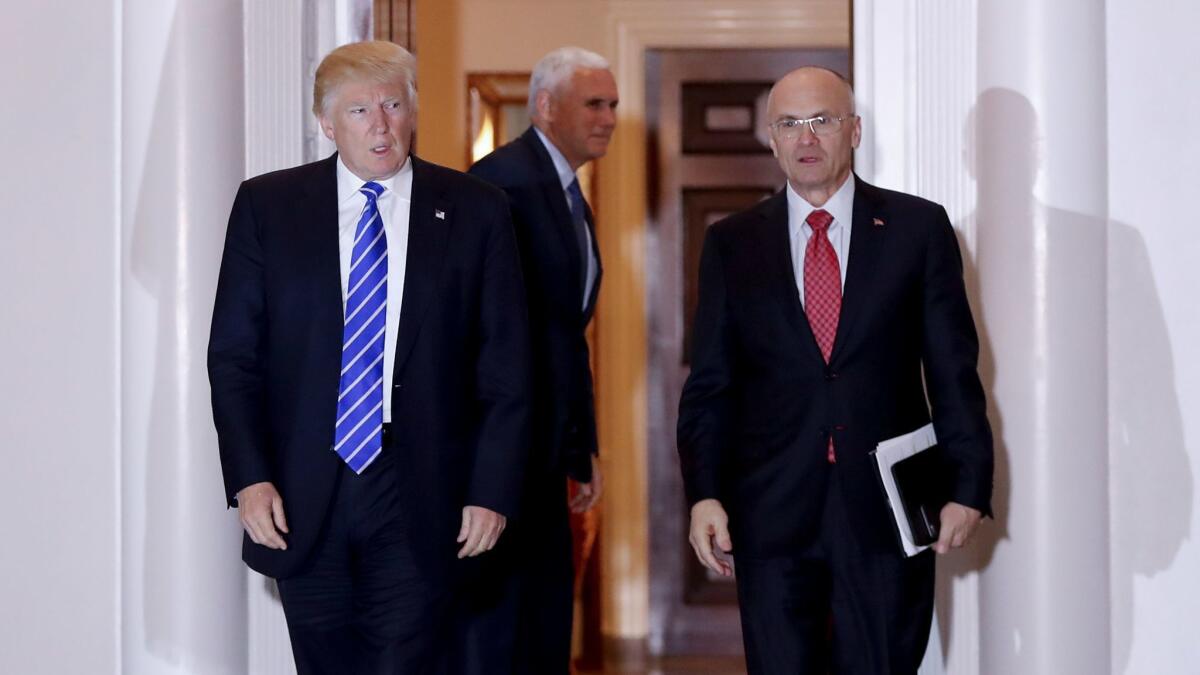Column: Will President Trump run roughshod over business expectations in 2017?

President-elect Donald Trump and Andy Puzder, nominee for secretary of Labor, leave the clubhouse of a Trump golf course in New Jersey.
- Share via
Business and the investment markets, it is often said, hate uncertainty. If that’s true, they’re going to absolutely abhor 2017.
Almost every new presidential administration that comes into office holds some of its plans and policies close to the vest, generally to maintain some flexibility of action. But few have inspired as many questions in the run-up to Inauguration Day as the Trump administration.
Trump vowed on the campaign trail to protect social insurance benefits, but pledged to “modernize” Medicare, usually a code for cutting benefits, in his post-election healthcare policy statement.
He vowed to punish U.S. companies that moved jobs abroad, but took credit after the election for a deal that will reward United Technologies with a $7-million tax break from Indiana for keeping 700 jobs in the state — while moving nearly twice as many to Mexico.
He ran on a platform of protecting the little guy from plutocrats and attacked Hillary Clinton, his Democratic opponent, for her ties to Wall Street, but has stocked his Cabinet with millionaires, billionaires and executives from Goldman Sachs.
It’s too early to stop worrying.... A strong focus on punitive tariffs and immigration bans could risk retaliatory responses from other nations.
— Joachim Fels, Pimco
The Donald Trump taking office hasn’t articulated a coherent philosophy or ideology of government. Not only are his own policy preferences murky, but so is his coming relationship with the Republican majorities in both congressional chambers. Their small-government, low-tax mind-set and hostility to social programs is much clearer, but how well that might sync with Trump’s agenda is an unknown.
U.S. investment markets went on a tear after the election, with the Standard & Poor’s 500 index rising about 5% and the Nasdaq composite about 4.4% through last week. This could reflect investor anticipation of a corporate tax cut and rollback of business regulations, which Trump and congressional Republicans advocate, and a generous infrastructure construction program, on which congressional opinion is more tepid.
But the enthusiasm may be premature.
“It’s too early to stop worrying” about Trump’s economic policies, argued Joachim Fels of Pimco in a post-election blog post. Among other concerns, “a strong focus on punitive tariffs and immigration bans could risk retaliatory responses from other nations,” while an overly aggressive Trump stimulus while the U.S. economy is already approaching full employment increases “the risk that the current expansion ends in tears in 2019 or 2020.”
There’s reason to be concerned about the ability of some of Trump’s Cabinet nominees to manage the large bureaucracies of their new agencies.
Secretary of Housing and Urban Development-designate Ben Carson, a former surgeon and presidential candidate, has never held public office. Indeed, when his name first came up as a potential secretary of Education or Health and Human Services, he seemed to take himself out of the running.
Lacking any background in housing policy but a mind-set hostile to government assistance programs, Carson will be in charge of an agency with a $47-billion budget and a history of financial scandal that even professional managers might find daunting.
Other appointees seem to have been chosen for their determination to vandalize the core missions of their agencies.
Trump’s choice for director of the Environmental Protection Agency, Oklahoma Atty. Gen. Scott Pruitt, is a climate change denier who labels himself “a leading advocate against the EPA’s activist agenda” and allegedly has ties to the energy industry, which routinely has been the target of EPA regulations.
The secretary of Labor-designate, fast-food executive Andrew Puzder, is the antithesis of a labor advocate: He comes from an industry beleaguered by Labor Department regulatory initiatives aimed at protecting work conditions and pay for its generally low-wage employees.
Few have as much potential to upend his department’s traditional mission as the nominee for secretary of Health and Human Services, Rep. Tom Price (R-Ga.). As Sherry Glied of New York University and Richard Frank of Harvard Medical School reported recently in the New England Journal of Medicine, Price, an orthopedic surgeon, generally opposes policies that expand healthcare access for the sick and poor, and favors initiatives that improve the “economic well-being” of their physicians.
He has voted against regulating tobacco as a drug, against funds for fighting AIDS and against expanding a government health insurance program for children. He also advocates policies that would lead to benefit cuts in Medicare and Medicaid.
Most notably, Price has been a resolute opponent of the Affordable Care Act and the sponsor of a bill that would eviscerate Obamacare. Among other provisions, Price would eliminate Medicaid expansion, which has brought health coverage to more than 11 million Americans in the 31 states and the District of Columbia that accepted the expansion.
Republican plans to dismantle Obamacare, which are supported by Trump, inject uncertainty not only for the more than 20 million Americans who have gained health coverage via the Affordable Care Act, but healthcare providers and insurance companies for whom the law has been a boon.
Almost all would be losers from repeal. Obamacare contributed to a reduction in uncompensated care costs for hospitals of as much as $7.4 billion, or 21%, by 2014 alone, according to an HHS estimate. Those costs could again be on the rise if Republican repeal-and-replace efforts end up increasing the rolls of the uninsured.
Then there are the insurers. Although news columns and Republican critics of the ACA have focused on the losses sustained by a few big insurers on individual insurance exchange plans, insurers big and small have been making a mint from Medicaid expansion.
UnitedHealth Group, which whined the loudest about Obamacare exchange losses and speedily withdrew from that end of the business, recorded growth of $8.3 billion, or 14.7%, in Medicaid revenue in the second quarter of 2016 compared to a year earlier. By the third quarter the company said it had added 500,000 new Medicaid customers and declared the program “a clear success of the Affordable Care Act.”
The area in which American industry may face the greatest uncertainty from Trump’s notions of how the world works and his style of decision-making is international trade. That’s also where he may find the greatest conflict with Congress.
In his campaign, Trump relentlessly bashed trade agreements such as the North American Free Trade Agreement, or NAFTA; Congress is full of Republican free-trade advocates.
Trump’s primary focus on the stump was China, which he depicted as a rapacious monolith that manipulates its currency and employs protectionism to destroy American industry so its own factories can fill the resulting vacuum. This is a direct channeling of his trade advisor Peter Navarro, a professor of economics and public policy at UC Irvine, whose recent books include “The Coming China Wars” (2006) and “Death by China: Confronting the Dragon” (2011).
Navarro has advanced the viewpoint that America’s trade deficit, especially with China, is a significant drag on U.S. economic growth. This notion has been questioned by economists and trade experts across the political spectrum.
“To Navarro, trade isn’t cooperation, but a winner-take-all competition … a zero-sum game, which produces national winners and national losers,” observes Dan Ikenson, a trade expert at the libertarian Cato Institute. Ikenson says that’s fundamentally wrong because it fails to acknowledge that trade can foster growth even for countries on the negative side of a trade imbalance, as the U.S. is with China.
The zero-sum-game view of trade held by Navarro and Trump is overly simplistic. The trade deficit — which encompassed a deficit in goods of $366 billion and a modest, $30-billion surplus in services, mostly due to Chinese tourists in the U.S. — totaled $336.2 billion in 2015. It is on track to approach but not exceed that figure in 2016.
But while China was the largest source of imported goods in the U.S., the impact of this trade on the U.S. economy can be overstated. Goods and services from China accounted for only 2.7% of U.S. personal consumption spending in 2010, according to a 2011 paper by Galina Hale and Bart Hobijn of the Federal Reserve Bank of San Francisco.
Moreover, only 45% of the value of “Made in China” imports actually reflected Chinese goods and labor. The rest — more than half — went to “U.S. businesses and workers transporting, selling, and marketing goods” marked with a Chinese label, according to the paper.
In other words, when you buy a China-made iPhone, more than half its cost may go to the truckers who got it into your hands, the landlord and employees of the Apple Store where you bought it, the shareholders of Apple and the company’s marketing program.
That points to an aspect of international trade often overlooked by China bashers like Trump: a significant portion of Chinese-made imports become components of U.S.-manufactured or assembled products — computers, phones, even aircraft. Boeing’s new flagship, the 787 Dreamliner, will fly with Chinese-made rudders and other parts.
Such relationships have implications for Trump’s expressed policy of imposing tariffs on Chinese imports. Trump’s campaign-era musing about a 45% import tariff would almost certainly trigger a global trade war that could cost the U.S. much more in lost exports than it would gain from reduced imports, reckoned Brandeis University economist Peter Petri. The consequences would be lost jobs and lower domestic wages.
But even a more modest tariff of 5% or 10% would probably mean pain for the average U.S. consumer. American factories simply aren’t geared up to make many of the parts and products we now import, so there would be shortages in major goods and higher prices for anything made with imported components as major manufacturers struggled to replace parts they source globally.
Workers and factories in industries with excess capacity to fill the vacuum would benefit, while most Americans would lose out.
You could count on Trump holding a photo opportunity at the isolated Midwestern factory that was able to ramp up to make nuts, bolts and steel washers, but not at Boeing, which would be smarting from the cancellation of multibillion-dollar orders by, say, Air China. Which do you think would have a bigger impact on the U.S. economy?
Those are just hints of the complex world that is about to impinge on the simplistic worldview offered by Trump during his presidential campaign. Think the business landscape was uncertain before? You ain’t seen nothing yet.
Keep up to date with Michael Hiltzik. Follow @hiltzikm on Twitter, see his Facebook page or email michael.hiltzik@latimes.com.
Return to Michael Hiltzik’s blog.







